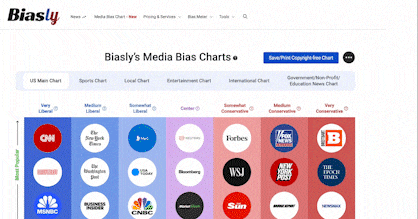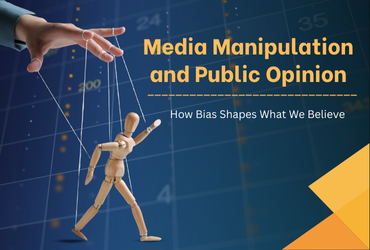
Media bias can manifest in many ways. An important way it can is through manipulation of public opinion. Often, viewers and readers don’t realize they are being influenced by what the producer wants them to believe. Media manipulation takes many forms: social media, misinformation from media networks, and covert methods like emotional appeals.
Manipulation from Media
Social Media
Social media is used to manipulate public opinion. There are multiple ways social media can be used to manipulate public opinion.
The first is through organized accounts. Organized accounts on social media designed to manipulate public opinion can be from one or multiple users. These accounts pose as valid news sources. They use polished visuals and AI to boost credibility on the surface.
They dupe readers into trusting their content and pull them away from accurate sources, as readers believe they are consuming unbiased news. However, these sources instead manipulate their audiences rather than informing them.
The other way social media can manipulate public opinion is through unorganized accounts. These users usually do not brand themselves in a professional manner and instead push out divisive content or misinformation. Followers of these unorganized accounts are often disillusioned with mainstream media. These people often view these non-traditional accounts as better than more organized sources on social media, as they think that the non-mainstream sources are not corrupt and are not looking to make money off their content. Yet, these unorganized sources still manipulate opinion. Their content is often biased, sometimes outright false, and pushes narratives that distort reality.
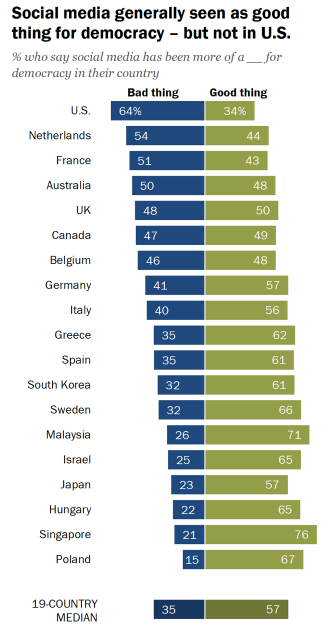
Source: Pew Research
The chart shows the percentage of people who think social media is good for democracy. Many Americans tend to think it’s not, possibly due to the large amounts of misinformation that circulate online.
Algorithmic Amplification on Social Media
Another way manipulation occurs is through the algorithms that power social media platforms. These algorithms prioritize content that generates clicks, comments, and shares, often pushing sensational or divisive stories to the top of people’s feeds. This creates echo chambers, where individuals repeatedly encounter similar viewpoints while opposing perspectives are hidden from view. As a result, people may become more polarized, convinced that their worldview is not only correct but also widely shared. Algorithm-driven amplification doesn’t just shape personal opinions—it can influence broader public debates, voter behavior, and even election outcomes.
Broadcast and Print Media
The next way public opinion is manipulated is through the news. Broadcast media—on TV or in print—also manipulates public opinion in several ways. One way the media does that is by deciding on what stories to report. Networks that have partisan leanings may promote certain political issues over others, despite that they occur at relatively the same frequency.
For example, a conservative outlet may focus on trans women in sports. The intent may be to push viewers toward negative views of the trans community. Regardless of one’s viewpoint on that issue, many viewers will likely see it as a larger political issue going forward, thus highlighting the effects of manipulating public opinion. Another example is when a liberal outlet portrays a conservative government as broadly negative and invites guests to criticize its leaders. This persuades viewers to believe the president and government are not doing a good job. In reality, it’s more debatable. The government’s performance is not defined by a few pundits’ opinions.
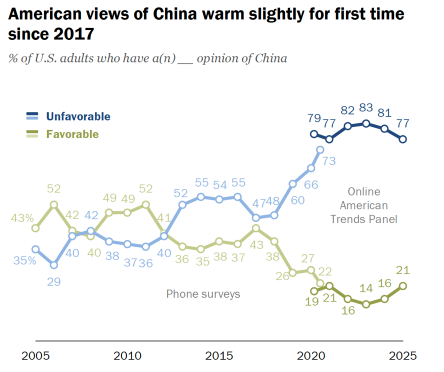
Source: Pew Research
More and more Americans tend to have an unfavorable view of China, largely because politicians and political media alike have antagonized China more and more in recent years.
The Rise of Fake News
Then there’s “fake news,” where outlets exaggerate details until the story itself seems unreal. People tend to be quick to point out what they deem as “fake news” if it comes from a source they do not approve of. Many don’t realize their favorite sources also use these tactics. They manipulate stories and, in turn, manipulate public opinion.
This often includes using quotes out of context to make a politician or opposing voice look bad. Networks or political media can edit words out of a speech or interview. This makes the public believe a person is worse than they truly are. However, there’s little disclosure when entities use these tactics, and many people fall for it, thus causing public opinion to shift on certain issues or events. Skewed reporting is not propaganda, but it still influences large audiences and shifts their views. On a larger scale, the manipulation of public opinion by the media can lead to changed outcomes in elections or other voting measures, conveying how important the media is in politics.
Manipulation from Influential People
Word Choices and Repetition
Strategic framing is another strategy to manipulate public opinion. Strategic framing is when articles or broadcasts frame headlines, word choice, or images with intentionality to have an effect on public opinion. The practice is not something that is easily noticeable, as outlets use more covert tactics to get their desired messaging across.
Partisan outlets use headlines in two ways: to promote their side or to attack opponents. For example, if a partisan news source published a story about allegations against a politician from the other side of the political spectrum, they might leave out words like “reportedly” or “allegedly” to make that individual sound more guilty and persuade their readers to believe that individual has already been proven guilty and that there is no need for further investigation.
Whereas if the allegations happened to someone that the publisher had more in common with politically, they might use more passive language to try to have the public feel that the specific individual is innocent, regardless of the facts of the case. Furthermore, to manipulate opinion, a network may deliberately sow doubt about stories that make their side look bad. This, in turn, creates a scenario where their subscribers have eroded trust in other sources across the spectrum and plays into public opinion being manipulated.
Repetitive word choice is a tool to shift public opinion. When outlets publish on the same topic repeatedly, opinion often changes. It could be negative, and cause a section of the public to be sick of hearing about it, downplaying and tuning the story out going forward. It could also be positive. Repeated coverage can make subscribers view an issue as more important and shift opinion in its favor, even giving it more attention than it deserves.
Influence of Celebrity Endorsements
Celebrities and influencers also play a major role in shaping public opinion. When a well-known figure endorses a political cause, promotes a protest, or criticizes a government policy, their large following amplifies the message far beyond what traditional media could achieve alone. Many people trust these voices more than journalists or politicians, because they feel a personal connection through entertainment or social media. This dynamic can be used to promote awareness of important issues, but it can also spread misinformation rapidly. Whether intentional or not, celebrity influence can shift debates, fuel public outrage, or normalize viewpoints that would otherwise remain at the margins.
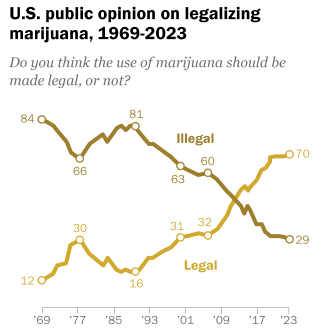
Source: Pew Research
Chart showing how Americans have warmed up to legalizing marijuana. This likely happened due to pop culture and social media showcases the use of marijuana more and more.
The Power of Images
Lastly, images are a strategy employed by political media outlets to alter public opinion. An example of this could be when a pro-life organization shares images of an aborted fetus rather than just talking about abortion. Outlets know such images provoke stronger reactions than essays. This can turn some in the public away from the pro-choice movement, as they perceive real horror in the images.
There are other instances, such as police brutality and war crimes, where outlets share those graphic images. Political outlets know that it not only brings awareness to the issue but that the images leave a lasting impact and drive some in the general public to be sympathetic to their causes.
Emotional Appeals and Fearmongering
The last way public opinion can be manipulated by the media is through rhetorical appeals. Writers and TV hosts alike appeal to things like emotion to get their viewers to feel something and change their opinions. Especially in cases where people really trust the sources they follow, appeals to emotion can have noticeable impacts on public opinion.
One example of these appeals to emotion is fearmongering. Fearmongering plays on people’s fears to push them away from one view and into another. For instance, a politician might tell their supporters that if they do not win the election, then bad things like an increase in crime or an erosion of democracy will occur. These claims are unlikely, though not baseless. They tap into real concerns within certain groups. That’s why politicians employ these tactics, as playing on the fears of people makes it more likely for them to change or have more hardened support for the candidate.
Widespread fearmongering drastically shifts opinion. It drives people away from candidates or issues without them realizing the hypotheticals are exaggerated.
Conclusion
These methods used by the media and politicians alike are integral causes of media manipulation. Manipulation doesn’t always affect a large share of the population. But on some issues, it can be enough to flip previously held opinions. This shows why it is important to diversify where one gets their news from, so that they can see multiple sides of the viewpoint.


























